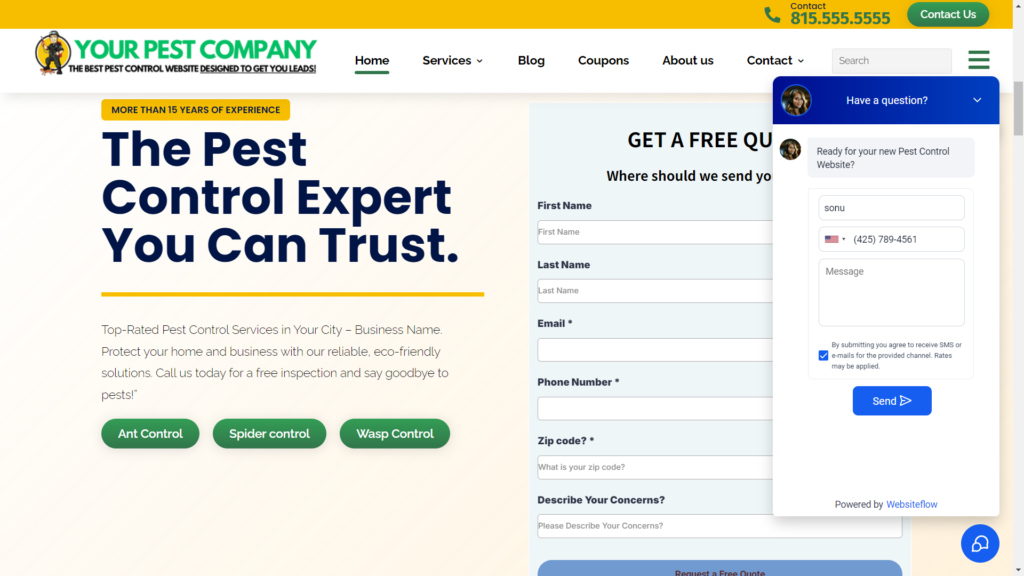In today’s digital age, having a website is crucial for any pest control business. It serves as your virtual storefront, attracting potential clients and providing information about your services. Whether you’re a small pest control startup or an established company, a well-designed website can boost your online visibility, increase customer trust, and generate leads. This guide will walk you through the steps of building a website that effectively showcases your pest control services.
Step 1: Plan Your Website Structure
Before diving into the technical aspects, start by planning your website’s structure. Think about the pages you want to include, the information you need to present, and the overall user experience. Essential pages for a pest control business website include:
- Homepage: A clear introduction to your services with a call to action (CTA) like “Get a Free Quote.”
- About Us: Share your company’s history, mission, and values.
- Services Page: Detail the pest control services you offer (e.g., termite control, rodent removal, mosquito treatments, etc.).
- Contact Us: Make it easy for visitors to reach you with a contact form, phone number, and email address.
- Blog: Add valuable content like pest prevention tips, seasonal pest problems, or company news. This also helps with SEO.
- FAQ: Address common customer questions such as pricing, pest control processes, and guarantees.
Step 2: Choose a Domain Name and Hosting Service
Your domain name is the web address for your site (e.g., www.yourpestcontrol.com). Choose something short, memorable, and reflective of your pest control business. Avoid long or complicated names that could confuse potential clients.
Next, you’ll need to pick a hosting service that will store your website’s files. Popular web hosting services include:
- Bluehost: Affordable and user-friendly for beginners.
- SiteGround: Known for excellent customer support and reliability.
- GoDaddy: Offers domain registration and hosting packages.
Step 3: Select a Website Building Platform
To make the website-building process simple, choose a platform that fits your technical ability and business needs. Some of the most common platforms are:
- WordPress: Offers full customization with thousands of themes and plugins. Perfect for businesses wanting more control.
- Wix: Ideal for small businesses looking for drag-and-drop simplicity.
- Squarespace: A great choice for businesses focused on design and ease of use.
Each platform provides templates that you can customize according to your brand’s colors, logo, and images.
Step 4: Design a User-Friendly Layout
A clean, user-friendly design is essential for keeping visitors engaged and guiding them toward action (like contacting you for pest control services). Here are a few design tips:
- Keep It Simple: Don’t overwhelm users with too much information or complex layouts.
- Highlight CTAs: Ensure that buttons like “Contact Us” or “Request a Free Estimate” are prominent and easy to find.
- Mobile-Friendly: Over 50% of web traffic comes from mobile devices. Make sure your site is responsive and works smoothly on smartphones and tablets.
- Use High-Quality Images: Include clear images of your services, team, or equipment to build trust.

Step 5: Optimize Your Website for SEO
Search Engine Optimization (SEO) is essential for ensuring your website ranks high on search engines like Google. When people search for pest control services in your area, you want your website to appear near the top of the results. Here are some key SEO strategies:
- Keyword Research: Identify the phrases potential clients use to search for services. Keywords like “pest control [your city],” “rodent removal,” or “termite treatment” should appear naturally throughout your site.
- On-Page SEO: Include your target keywords in titles, meta descriptions, headers, and throughout your content. But avoid keyword stuffing, which can hurt your rankings.
- Local SEO: Since pest control is location-specific, add your business’s name, address, and phone number (NAP) consistently across the site. Claim your business on Google My Business and add a location-based keyword to your pages (e.g., “Pest Control in Dallas”).
- Fast Loading Times: Use tools like Google PageSpeed Insights to ensure your website loads quickly. Slow websites can drive away visitors.
- Content Marketing: Regularly updating your blog with relevant pest control topics can help attract more traffic and improve your SEO ranking.
Step 6: Add Important Features
Your pest control website should have essential features that enhance user experience and help convert visitors into leads:
- Online Booking System: Allow customers to schedule appointments directly on your site.
- Live Chat: Provide instant customer support to answer questions in real-time.
- Customer Reviews: Display reviews and testimonials from satisfied clients to build trust.
- Service Area Map: Show a map of the areas you serve to attract local clients.
- Contact Form: Ensure it’s easy for potential customers to request more information or book services.
Step 7: Test and Launch
Once your website is designed and built, thoroughly test it to ensure everything works properly. Check that all links are functioning, forms are sending submissions, and pages load quickly. It’s also a good idea to preview your site on different devices and browsers to make sure it’s fully responsive.
When everything is ready, publish your website. Share it on social media, add it to your email signatures, and promote it in local directories or advertisements to attract more traffic.
Building a professional website for your pest control business is a critical step toward attracting new customers and growing your online presence. By following this guide, you can create a website that’s easy to navigate, SEO-friendly, and tailored to your specific services. Whether you’re DIY-ing it with tools like WordPress or hiring a web developer, a strong website is essential for any pest control business in today’s competitive market.
Start Your Business Today with all in one solution pest control Website!
Start A Successful Pest Control Business with all in one solution website!
We know the pest control Company!
✓ Easy to use
✓ automated ✓ Seo mobile optimized ✓ Features for growth


